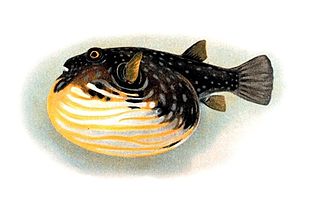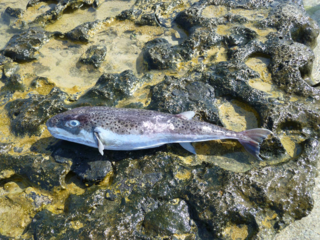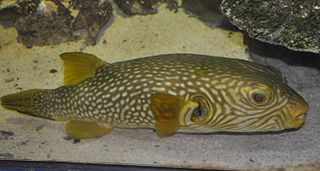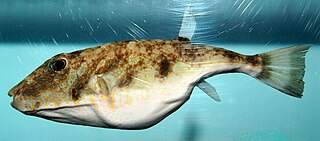
Tetraodontidae is a family of primarily marine and estuarine fish of the order Tetraodontiformes. The family includes many familiar species variously called pufferfish, puffers, balloonfish, blowfish, blowers, blowies, bubblefish, globefish, swellfish, toadfish, toadies, toadle, honey toads, sugar toads, and sea squab. They are morphologically similar to the closely related porcupinefish, which have large external spines. The scientific name refers to the four large teeth, fused into an upper and lower plate, which are used for crushing the hard shells of crustaceans and mollusks, their natural prey.

Porcupinefish are medium-to-large fish belonging to the family Diodontidae from the order Tetraodontiformes which are also commonly called blowfish and, sometimes, balloonfish and globefish. They are sometimes collectively called pufferfish, not to be confused with the morphologically similar and closely related Tetraodontidae, which are more commonly given this name.

Lagocephalus is a genus of fish in the family Tetraodontidae (pufferfish) with a circumglobal distribution.

The oceanic puffer, sci-name: Lagocephalus lagocephalus, is a pufferfish of the family Tetraodontidae, found in all tropical and subtropical oceans, at depths of between 10 and 475 m. Though indigenous to the Pacific, Atlantic and Indian oceans as well as the Sea of Japan, a surge in its distribution throughout the Mediterranean Sea has been reported in years of recent. Its length is up to 61 cm. It is thought to be responsible for fatal poisoning and should therefore not be eaten.
Sicyopterus lagocephalus, the red-tailed goby or blue stream goby, is a species of goby native to islands of the Indian Ocean from the Comoros to the Mascarene Islands to the Pacific Ocean where it reaches French Polynesia and can be found as far north as Japan. It is an amphidromous species: adults can be found in swift-flowing streams with rocky beds but the eggs hatch at sea and the larval stage remains in marine waters, migrating to freshwaters when they reach the postlarval stage. This species can reach a total length of 13 cm (5 in). In some places it is an important species for local consumption with the post-larvae being caught as they mass in estuaries.

Leiodon cutcutia, the ocellated pufferfish, is a species of pufferfish native to southern Asia from India to the Malay Archipelago where it is found in various bodies of fresh and brackish waters. This species grows to a length of 15 centimetres (5.9 in) TL. It is currently the only known member of its genus, but it was included in Tetraodon until 2013.

Arothron stellatus, also known as the stellate puffer, starry puffer, starry pufferfish, or starry toadfish, is a demersal marine fish belonging to the family Tetraodontidae. It is found in shallow water in the Indo-Pacific region.

Lagocephalus spadiceus, also known as the half-smooth golden pufferfish, is a species of fish in the family Tetraodontidae. It is a common fish in the Red Sea, as well as the Indian Ocean, but can be found also in the Mediterranean, where it arrived from its natural habitat by Lessepsian migration.

Lagocephalus sceleratus, commonly known as the silver-cheeked toadfish, or Sennin-fugu, is an extremely poisonous marine bony fish in the family Tetraodontidae.

Torquigener pleurogramma, commonly known as the weeping toadfish or blowie, is a species of fish in the family Tetraodontidae. It is found in the coastal waters of Australia. Its flesh is highly toxic.

Arothron reticularis, variously known as the reticulated pufferfish, reticulated blowfish or reticulated toadfish, is a ray-finned fish in the family Tetraodontidae. It is native to the tropical and sub-tropical Indo-Pacific region where its habitats include sandy and muddy seabeds, coral reefs, estuaries and mangrove areas.
The diamondback puffer is a species of pufferfish in the genus Lagocephalus.
Arothron carduus is a ray-finned fish in the family Tetraodontidae. It is an uncommon species and is native to the tropical and sub-tropical Indo-Pacific region.
Auriglobus nefastus, known as the greenbottle pufferfish, is a species of pufferfish in the family Tetraodontidae. It is a freshwater species native to Asia, where it may be found from the Mekong basin to Indonesia. It occurs in fast-flowing waters of rivers and streams, although it is known to enter flooded forests and plains when river water levels rise. It feeds on the scales and fins of other fish and reaches 13 cm SL. The common name of the species comes from its coloration, which ranges from light green to golden.

Canthigaster sanctaehelenae, known as the St. Helena sharpnose pufferfish, is a species of pufferfish in the family Tetraodontidae. It is native to the Southeast Atlantic, where it is known only from the islands of St. Helena and Ascension. It is a reef-associated species that occurs in tidal pools and rocky areas at depths of 50 m (164 ft) or less. Adults of the species are usually seen in pairs. It reaches 6.7 cm SL. It differs from other Atlantic Canthigaster species in patterning, with neither longitudinal dark stripes on the body or caudal peduncle nor a conspicuous dark spot on the dorsum.

Chelonodontops patoca, also known as the milk-spotted pufferfish, milkspotted puffer, milkspotted toadfish, Gangetic blow fish, Gangetic pufferfish, or marbled toad, is a species of pufferfish in the family Tetraodontidae native to the Indo-Pacific. It ranges from East Africa to the Western Pacific from Korea in the north to northern Australia in the south. It is a tropical species that occurs in coastal waters, lagoons, estuaries, and rivers. While it does enter fresh water, the species does not occur more than a few kilometres from the sea. It is often seen in schools which sometimes enter freshwater streams. It is usually found at a depth range of 4 to 60 m and reaches 38 cm (15 in) standard length. The species is poisonous but reportedly considered a delicacy in Japan.

Lagocephalus inermis, known as the smooth blaasop, is a species of pufferfish in the family Tetraodontidae native to the Indo-Pacific. It is a marine species that ranges from Algoa Bay in South Africa to southern Japan, where it occurs at a depth range of 10 to 200 m and inhabits the edge of the continental shelf. It is a very large pufferfish, reaching 90 cm SL. It closely resembles the Atlantic species Lagocephalus laevigatus, but it can be distinguished from that species by its black gill opening. Additionally, it does not overlap in range with L. laevigatus. It is reported to be demersal and oviparous.
Lagocephalus suezensis is a species of pufferfish of the family Tetraodontidae. It is native to the western Indian Ocean and recorded in the Mediterranean Sea since 1977. It has since spread in the eastern Mediterranean Basin. It reaches 18 cm in total length and inhabits sandy and muddy bottoms down to 40 m. It is often confused with Lagocephalus sceleratus in Australia.

Sphoeroides dorsalis, known as the marbled puffer, is a species of pufferfish in the family Tetraodontidae. It is native to the Western Atlantic, where it ranges from North Carolina to Suriname and occurs at a depth of 18 to 100 m. It is a demersal oviparous species found over soft bottoms that reaches 20 cm in total length.

Takifugu oblongus, known as the oblong blowfish or lattice blaasop, is a species of pufferfish in the family Tetraodontidae. It is native to the Indo-Pacific, where it ranges from South Africa to Indonesia, Japan, and Australia. It lives primarily in coastal marine environments, although it is known to enter brackish water. The species reaches 40 cm SL.
















